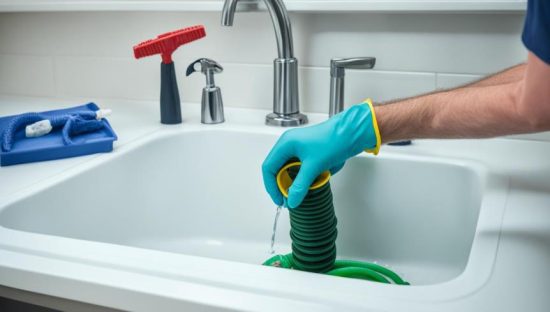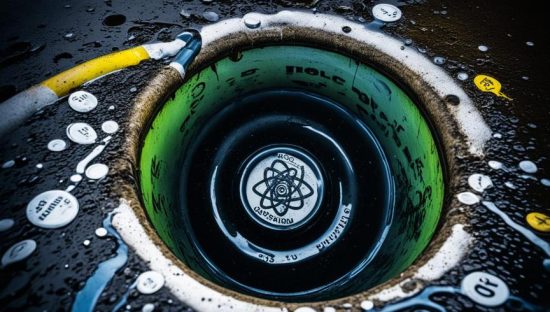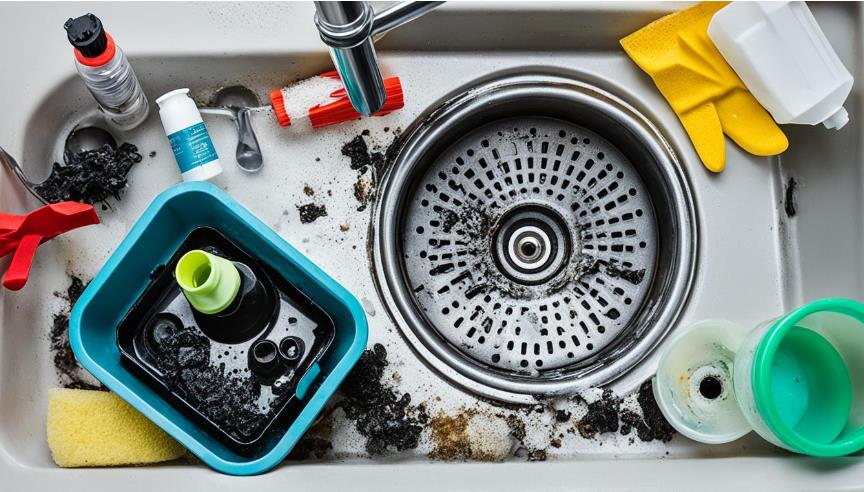Are you tired of dealing with a clogged kitchen sink that has a garbage disposal? Do you find yourself frustrated with slow draining water and unpleasant odors coming from your sink? It’s time to take matters into your own hands and learn how to unclog your kitchen sink effectively.
In this section, we will explore five different methods for unclogging a kitchen sink that has a garbage disposal. Whether you’re dealing with a minor clog or a stubborn blockage, these methods will help you restore the proper functioning of your sink and get rid of those pesky clogs for good.
So, are you ready to learn how to unclog your kitchen sink with a garbage disposal? Let’s dive in and discover the solutions that will make your life in the kitchen much easier!
Understanding Your Kitchen Sink and Garbage Disposal System
Let’s begin by discussing the function and operation of a garbage disposal. A garbage disposal is an essential component of your kitchen sink that helps to grind and eliminate food waste. It is typically located below the sink, connected to the drain and plumbing system.
The key components of a kitchen sink and garbage disposal system include:
- Kitchen Sink: The sink allows you to wash dishes and prepare food. It is connected to the garbage disposal through the drain.
- Garbage Disposal Unit: This is the main component responsible for grinding and eliminating food waste. It consists of a motor, grinding blades, and a housing unit.
- Mounting Hardware: The mounting hardware secures the garbage disposal unit to the bottom of the sink.
- Electrical Connections: The garbage disposal is powered by electricity, and it is connected to an electrical outlet or wiring.
- Drainpipe: The drainpipe connects the garbage disposal to the plumbing system, allowing the waste particles to be flushed away.
Signs of a Clogged Garbage Disposal
This section will highlight the signs and indicators of a clogged garbage disposal. You will learn to recognize warning sounds that may indicate a clog, such as grinding or humming noises, as well as identify water backup issues in your kitchen sink. Understanding these signs will allow you to detect clogs early and take prompt action to prevent further damage to your garbage disposal and plumbing system.
Recognizing the Warning Sounds
When it comes to identifying a clogged garbage disposal, paying attention to warning sounds is crucial. Garbage disposal warning sounds such as grinding or humming noises can indicate a clog. If you hear grinding noises, it may suggest that hard objects or food debris are obstructing the disposal blades. On the other hand, humming noises may indicate that the motor is struggling to spin due to a clog in the system. If you notice these warning sounds, it’s important to address the issue promptly to prevent further damage.
Identifying Water Backup Issues
Another indication of a garbage disposal clog is water backup in your kitchen sink. If you notice that water is backing up or draining slowly after running the garbage disposal, it could be a sign of a clog. This backup occurs when the water doesn’t have a clear pathway to flow through due to a blockage in the disposal or the pipes. The presence of standing water or slow drainage indicates the need to investigate and resolve the clog to avoid potential plumbing problems.
Risks of Using Chemical Drain Cleaners
Chemical drain cleaners often contain harsh and corrosive substances such as sulfuric acid or sodium hydroxide. When poured down the drain, these chemicals can eat away at the pipes and components of your garbage disposal, leading to leaks, cracks, or total system failure.
Not only can chemical drain cleaners harm your garbage disposal, but they can also pose a risk to your health and the environment. Exposure to these chemicals can cause skin, eye, and respiratory irritation. Moreover, these chemicals can contaminate water sources and harm aquatic life.
Fortunately, there are alternative natural methods for unclogging your kitchen sink without using harmful chemicals. These methods are not only safer for your garbage disposal but also more environmentally friendly.
By adopting natural methods, such as using a combination of baking soda and vinegar, or employing manual clog removal techniques, you can ensure the longevity and effectiveness of your garbage disposal while avoiding the risks associated with chemical drain cleaners.
How to Unclog a Kitchen Sink With a Garbage Disposal

In this section, we will provide you with a step-by-step guide on how to unclog a kitchen sink that has a garbage disposal. Whether you’re dealing with a minor clog or a stubborn blockage, these effective methods will help you restore the proper functioning of your sink.
Following are the effective three methods that van be used while the kitchen sink is clogged. This methods are only applicable to the kitchen sinks have garbage disposal.
Method One: Manual Clog Removal Techniques
In this section, you will learn about the first method for unclogging a kitchen sink with a garbage disposal, which involves using manual clog removal techniques. Manual clog removal techniques are effective in dislodging and removing stubborn clogs that may be causing your kitchen sink to drain slowly or not at all. This method allows you to physically clear the blockage and restore the proper flow of water in your sink.
Tools and Precautions
To successfully remove clogs manually, you will need a few essential tools. These tools include a pair of sturdy gloves, a plumbing snake or auger, and a bucket or container to catch any water that may spill during the process. The gloves will protect your hands while dealing with potential debris, while the plumbing snake or auger will help you reach and break up the clog.
Before you begin, it’s important to take certain precautions to ensure your safety. Make sure to disconnect the garbage disposal from the power source to prevent any accidental activation during the clog removal process. Additionally, always exercise caution when working with sharp objects and follow the manufacturer’s instructions for using the plumbing snake or auger.
Step-by-Step Manual Removal
- Start by disconnecting the power supply to your garbage disposal. This will prevent any accidental activation while working on the clog.
- Put on your gloves to protect your hands from any debris or sharp objects.
- Locate the drain pipe connection on the garbage disposal unit. This is where you will insert the plumbing snake or auger.
- Insert the plumbing snake or auger into the drain pipe connection and start turning the handle or cranking the mechanism. Continue to push the snake or auger into the pipe until you feel resistance.
- Once you reach the clog, apply steady pressure and utilize the tool’s twisting or rotating motion to break up the blockage. Be careful not to force the snake or auger too aggressively, as this can damage the pipes.
- Slowly retract the snake or auger, being mindful of any debris or clog material that may come out with it.
- Once you have removed the snake or auger, reconnect the power supply to the garbage disposal. Test the sink by running water and check if the clog has been successfully cleared.
- If the clog persists, you may need to repeat the process or consider trying another method outlined in the article.
Method Two: Natural Cleaning Solutions
This section will focus on the second method for unclogging a kitchen sink with a garbage disposal, which involves using natural cleaning solutions. By using these natural cleaning solutions, you can safely and effectively unclog your sink without resorting to harmful chemicals.
Using Baking Soda and Vinegar for Safe Unclogging
One of the most effective natural cleaning solutions for unclogging a sink with a garbage disposal is a combination of baking soda and vinegar. This powerful duo works together to break down food debris and dissolve clogs, restoring the proper flow of water in your sink.
To unclog your sink using baking soda and vinegar, follow these steps:
- Start by pouring a pot of boiling water down the drain to soften the clog.
- Next, sprinkle about half a cup of baking soda directly into the drain.
- Follow the baking soda with half a cup of vinegar. The combination of baking soda and vinegar will create a fizzing action that helps break down the clog.
- Allow the fizzing action to continue for about 15-20 minutes.
- After the fizzing action has subsided, flush the drain with another pot of boiling water to clear away any remaining debris.
Optimizing the Fizzing Action for Effective Clog Removal
To optimize the fizzing action of the baking soda and vinegar solution, you can take the following steps:
- Ensure that the baking soda reaches deep into the drain by using a spoon or any suitable tool to push it down.
- Seal the drain opening with a rubber stopper or a cloth to trap the fizzing action inside the pipe, allowing it to work more effectively on the clog.
- After the fizzing action has subsided, remove the stopper or cloth and flush the drain with boiling water to wash away the dissolved debris.
By optimizing the fizzing action, you can enhance the effectiveness of the baking soda and vinegar solution in breaking down clogs and ensuring a fully unclogged sink.
Method Three: Plunging Your Way to a Solution

In this section, we will explore the third method for unclogging a kitchen sink with a garbage disposal – plunging. Plunging is an effective technique that can dislodge clogs and restore proper water flow in your sink. By following the correct plunging method and implementing some helpful tips, you can maximize your chances of successfully unclogging your sink.
The Correct Way to Plunge a Kitchen Sink
To plunge your kitchen sink effectively, follow these steps:
- Ensure that the garbage disposal is turned off and unplugged to prevent any accidental activation during the plunging process.
- Fill the sink with enough water to cover the plunger cup.
- Place the plunger cup directly over the drain, ensuring a tight seal.
- Push the plunger downward firmly, then pull it back up forcefully. Repeat this motion several times.
- After several plunges, quickly remove the plunger to allow water to flow and check if the clog has been dislodged. If the water drains smoothly, the clog has been successfully cleared.
Remember to avoid using too much force while plunging, as it can damage your garbage disposal or plumbing system. A firm and consistent motion are key for effective plunging.
Tips to Ensure Effective Plunging
Here are some additional tips to enhance the effectiveness of your plunging efforts:
- Use a high-quality rubber plunger with a strong suction cup for better results.
- Apply petroleum jelly or water to the plunger’s rim to create a stronger seal.
- Avoid using a plunger directly on a double-bowl sink, as it may cause water to splash and create a mess. Instead, block the unclogged side of the sink with a wet cloth or stopper.
- If plunging doesn’t initially resolve the clog, try repeating the process multiple times. For stubborn clogs, you may need to combine plunging with other methods or seek professional assistance.
Method Four: Tackling Clogs with a Hex Wrench or Wooden Handle
In this section, we will introduce the fourth method for unclogging a kitchen sink with a garbage disposal, which involves using a hex wrench or a wooden handle. You will learn how to use a hex wrench on garbage disposals that have a hexagon hole, as well as discover an alternative method using a wooden handle when no hex hole is present. These techniques provide alternative options for removing clogs from your sink and restoring proper drainage.
How to Use a Hex Wrench on Garbage Disposals
If your garbage disposal has a hexagon-shaped hole on the bottom, you can use a hex wrench to unclog it. Start by locating the hexagon hole, usually found in the center of the disposal’s underside. Insert the hex wrench into the hole and rotate it back and forth to dislodge and break up the clog. Apply gentle pressure and avoid using excessive force to prevent damage to the disposal.
Alternative: Using a Wooden Handle When No Hex Hole is Present
If your garbage disposal does not have a hexagon hole, you can use a wooden handle as an alternative method for unclogging. Begin by turning off the power to the disposal to ensure safety. Insert the handle into the drain opening and use it to manually rotate the grinding plate or impeller. This motion will help dislodge the clog and restore proper drainage.
Method Five: When to Call a Plumbing Expert
This section will discuss the fifth method for unclogging a kitchen sink with a garbage disposal, which involves knowing when to call a plumbing expert. You will learn how to assess the severity of a clog and identify signs that indicate the need for professional help. By understanding when it’s necessary to call a plumbing expert, you can ensure the timely resolution of complex clogs and prevent further damage to your kitchen sink and garbage disposal.
Assessing the Severity of the Clog

When facing a stubborn kitchen sink clog, it’s essential to assess the severity of the situation. Start by observing the flow of water in your sink. If the water drains slowly or not at all, it may indicate a more significant clog that requires professional intervention. Pay attention to any unusual smells emanating from your sink as well, as this could be a sign of a severe clog.
Additionally, consider the duration of the clog. If you have attempted various unclogging methods without success and the clog persists for an extended period, it’s a clear indication that professional help is needed.
Understanding When Professional Help is Necessary
While it’s often possible to unclog a kitchen sink with a garbage disposal using DIY methods, certain signs indicate the need for expert assistance. Here are a few scenarios where calling a plumbing expert is necessary:
1. Recurring Clogs: If you frequently experience clogs in your kitchen sink, it may be a sign of an underlying issue that requires professional diagnosis and repair.
2. Multiple Fix Attempts: If you have tried multiple unclogging methods without success, it’s time to seek the expertise of a plumbing professional. They have the necessary tools and experience to tackle complex clogs effectively.
3. Gurgling Sounds: Unusual gurgling sounds coming from your sink when using the garbage disposal can indicate a serious clog or a potential problem with the disposal unit itself. A plumbing expert can identify the underlying cause and provide the appropriate solution.
Remember, calling a plumbing expert not only ensures the proper resolution of complex clogs but also prevents further damage to your kitchen sink and garbage disposal. Don’t hesitate to seek professional help when needed to maintain the optimal functionality of your sink and disposal system.
Preventive Measures to Avoid Future Clogs
Now that you have learned effective methods for unclogging your kitchen sink with a garbage disposal, it’s time to focus on preventive measures to avoid future clogs. By implementing these simple tips and techniques, you can maintain the smooth and efficient functioning of your sink and disposal, ultimately saving time and resources.
One crucial preventive measure is to be mindful of what goes down your kitchen sink. Avoid disposing of large food scraps and fibrous materials, such as coffee grounds and eggshells, as they can easily contribute to clogs. Instead, scrape off excess food into the trash or compost bin before rinsing your dishes.
Regular cleaning of your kitchen sink and garbage disposal is also essential in preventing clogs. After each use, run a stream of cold water through the disposal to flush away any remaining food particles. It is recommended to perform a thorough cleaning once a month by pouring a mixture of half a cup of baking soda and half a cup of vinegar down the drain. Let it sit for a few minutes, then flush with hot water to remove any buildup.
Finally, scheduling routine maintenance for your garbage disposal is crucial in avoiding future clogs. Consider hiring a plumbing expert to inspect and service your disposal annually. They can identify any potential issues and provide appropriate solutions to ensure the long-term functionality and durability of your kitchen sink and garbage disposal system.
FAQ for Unclogging Kitchen Sink
Is it okay to plunge a kitchen sink with a garbage disposal?
Yes, plunging can be an effective method to unclog a kitchen sink with a garbage disposal. However, you should follow the correct plunging technique and ensure that there are no loose objects or debris that could potentially damage the disposal or plumbing system.
Why does my kitchen sink back up when I run the garbage disposal?
If your kitchen sink backs up when you run the garbage disposal, it could indicate a clog in the drainpipe or disposal unit. The clog may be caused by food debris, grease buildup, or other foreign objects. It’s important to address the clog promptly to prevent further damage.
How to unclog a double kitchen sink with standing water with a garbage disposal?
To unclog a double kitchen sink with standing water and a garbage disposal, you can try using manual clog removal techniques such as using a plunger or a drain snake. If these methods don’t work, you may need to remove the pipe trap or seek professional help to resolve the clog.

